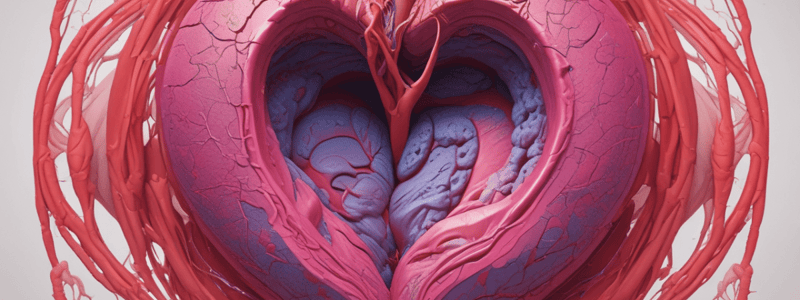Podcast
Questions and Answers
What is the main pathogenetic mechanism of venous thrombosis?
What is the main pathogenetic mechanism of venous thrombosis?
- Atherosclerosis
- Endothelial cell injury
- Turbulence
- Stasis and hypercoagulability (correct)
Which vein is most commonly affected by deep vein thrombosis (DVT)?
Which vein is most commonly affected by deep vein thrombosis (DVT)?
- Iliac vein
- Popliteal vein (correct)
- Femoral vein
- Aorta
What clinical setting is NOT associated with the occurrence of deep vein thrombosis (DVT)?
What clinical setting is NOT associated with the occurrence of deep vein thrombosis (DVT)?
- Pulmonary hypertension (correct)
- Advanced age
- Postpartum states
- Congestive heart failure
What is the composition of a thrombus primarily determined by?
What is the composition of a thrombus primarily determined by?
In what circulation does a thrombus formed in slow-moving blood flow typically occur?
In what circulation does a thrombus formed in slow-moving blood flow typically occur?
What are the primary abnormalities that lead to thrombosis, according to the Virchow triad?
What are the primary abnormalities that lead to thrombosis, according to the Virchow triad?
Which factor plays an important role in initiating both hemostasis and thrombosis after endothelial injury?
Which factor plays an important role in initiating both hemostasis and thrombosis after endothelial injury?
Which condition leads to Endocardial injury that can cause thrombus formation?
Which condition leads to Endocardial injury that can cause thrombus formation?
What is the fate of a thrombus that undergoes organization and recanalization?
What is the fate of a thrombus that undergoes organization and recanalization?
In what type of blood flow is there normally an axial laminar flow in which the most rapidly moving central stream consists of leukocytes and red cells?
In what type of blood flow is there normally an axial laminar flow in which the most rapidly moving central stream consists of leukocytes and red cells?
Which of the following accurately describes the composition of venous thrombi?
Which of the following accurately describes the composition of venous thrombi?
What is a characteristic feature of valve thrombosis (vegetations) in infective endocarditis?
What is a characteristic feature of valve thrombosis (vegetations) in infective endocarditis?
Which of the following is a potential fate of a thrombus if the patient survives the immediate effects?
Which of the following is a potential fate of a thrombus if the patient survives the immediate effects?
Which process is involved in the organization and recanalization of a thrombus?
Which process is involved in the organization and recanalization of a thrombus?
What is a characteristic microscopic feature of arterial and cardiac (mural) thrombi?
What is a characteristic microscopic feature of arterial and cardiac (mural) thrombi?
Which of the following is true regarding the microscopic composition of a venous thrombus?
Which of the following is true regarding the microscopic composition of a venous thrombus?
What is the potential consequence of valve thrombosis in the deep veins of the lower limbs?
What is the potential consequence of valve thrombosis in the deep veins of the lower limbs?
Which of the following is the most common fate of a venous thrombus in the lower extremities?
Which of the following is the most common fate of a venous thrombus in the lower extremities?
What is the process by which a thrombus becomes adherent to the vascular wall and undergoes remodeling?
What is the process by which a thrombus becomes adherent to the vascular wall and undergoes remodeling?
In the process of recanalization, what happens to the thrombus?
In the process of recanalization, what happens to the thrombus?
Flashcards are hidden until you start studying




